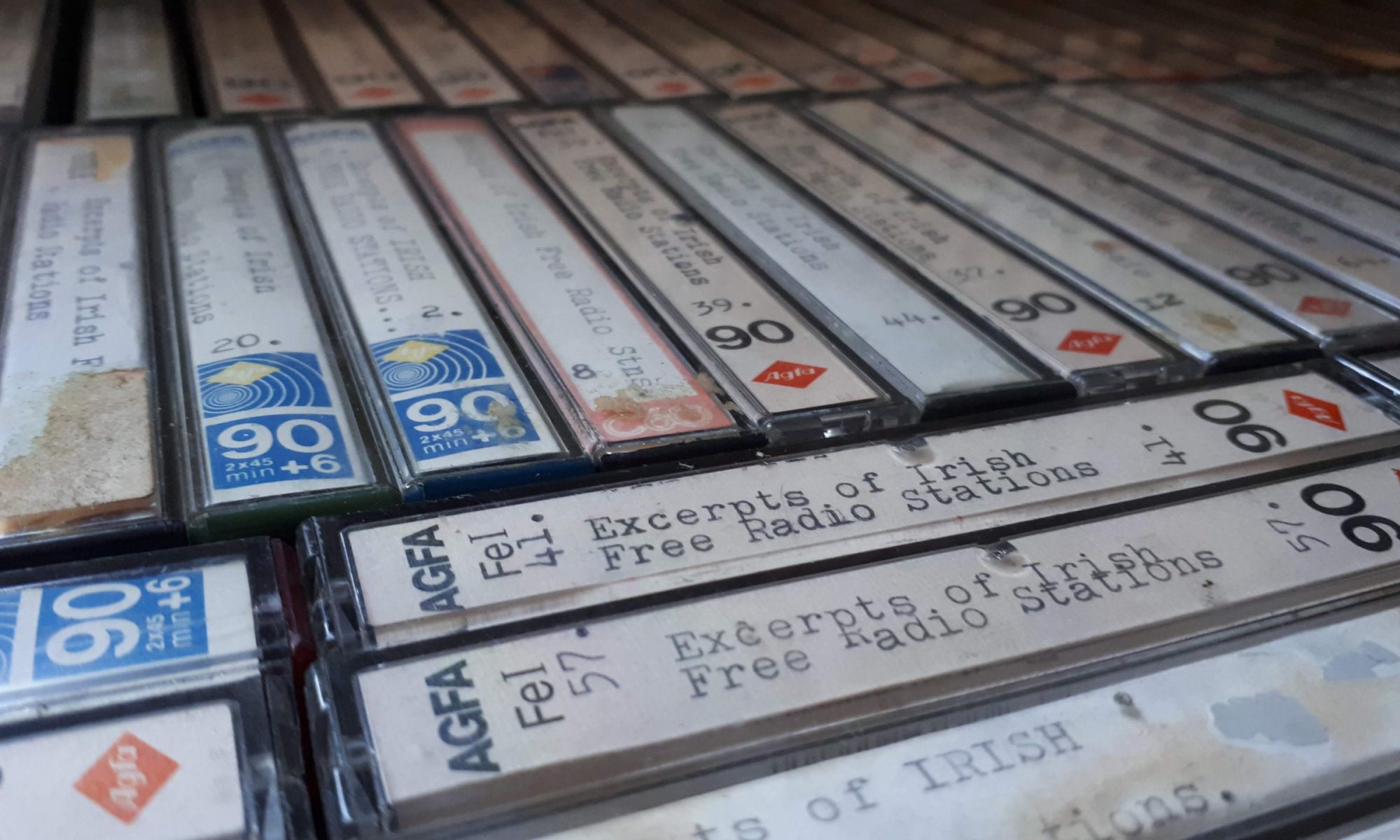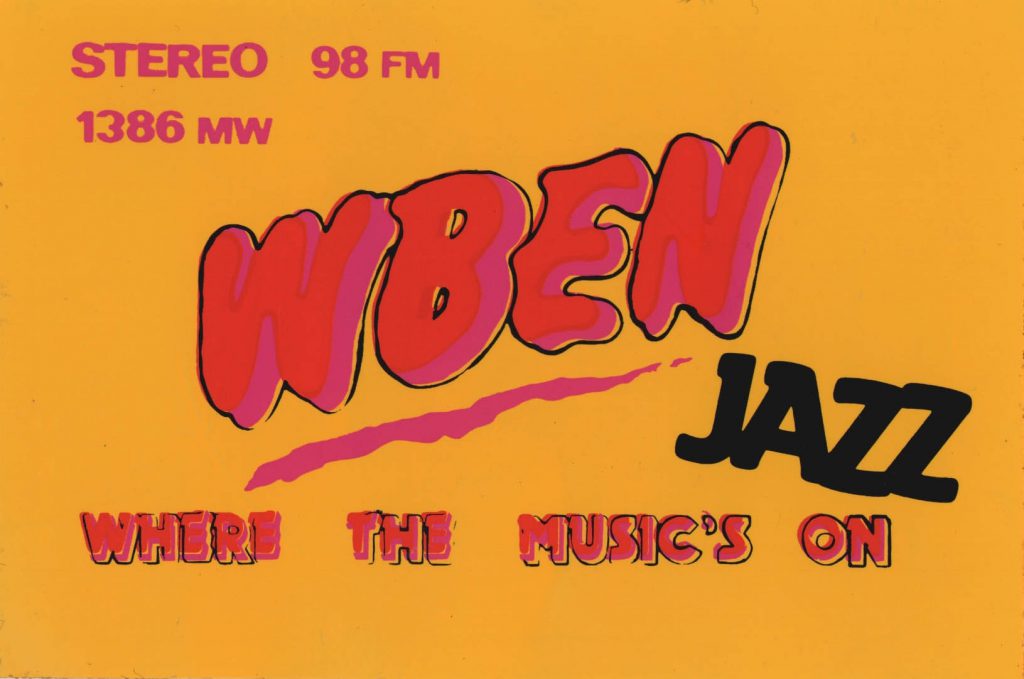Podcast: Play in new window | Download

WBEN began broadcasting to Cork city on 98FM over the Cork Jazz Festival weekend at the end of October 1985. The station was based in Cook Street in the centre of Cork city and the transmitter, a stereo 35 watt rig, was initially located in the same building as the studio. Romano Macari and Pete O’Neill were the principals behind the station.
Gearóid Ó Cuill writes: I recall first hearing the station on Saturday of the Jazz weekend in October 1985. A friend in Donnybrook, Douglas had purchased a new ‘3 in 1’ stereo and invited me over to see it. The first part I checked was the radio (an analogue FM tuner) and as I tuned across the band I noticed a very nicely modulated stereo signal on 98 FM. We heard an American sung jingle which identified the station as WBEN and another jingle mentioned ‘FM 98’. We were impressed by the beautiful audio from the station and the American music and style. The music was continuous with no advertising on that occasion. I monitored the station over the next few weeks and the station featured continuous music 24/7 without presentation and was operating an ‘automated’ style. The station was not in fact automated but relied on mainly unpaid enthusiastic local DJs who were not allowed talk on air. From relatively early on local advertising appeared on the station, some voiced by Pete O’Neill so it became clear that Pete had a significant role at the station. Tony Magnier worked as a DJ for WBEN during its first phase and he recalls the station played 100% US Billboard Hot Hits although this was diluted later to include some UK releases. While coverage was limited from low-lying Cook Street, it covered well the inner city area and the suburbs on the hills around the city. It was notable for excellent compression and there was a practice of speeding up records slightly by altering the pitch control on the turntables. This gave the compression a lively quality and only the most observant of listeners would have noticed the pitch alteration!
The station stayed with this format for approximately 6 months and I recall hearing it often in boutiques, shops and pubs in the city centre. At the time ERI was still transmitting from White’s Cross, a few miles north of the city centre, so reception of WBEN, being in the city centre, was actually better in some shops. The only other pirate of significance at the time was South Coast Radio (version 2) which had launched in the summer of 1985 using a relatively small mono FM transmitter based over its studio on North Main Street. In December 1985 another station, Leeside Sound, started broadcasting using a professional 250 watt CTE on 101.5 FM in stereo from a premises on the North Mall.”
Around May 1986 WBEN embarked on a major expansion introducing live presentation and bringing on board ex Caroline DJs Nick Richards and Neil Francis. The line-up also included Eamonn Kelly, Steve Douglas, Rob Allen, Paul Byrne, Siobhán Walls and ex-ERI DJs Neil Prenderville and Hugh Browne (RIP). Keith York (RIP) occasionally filled in for presenters on leave.
Around this time WBEN introduced a medium wave transmitter and moved the FM transmitter to an elevated site to improve coverage. The medium wave transmitter was located on a farm a couple of miles outside the city to the northwest. 1566 kHz was initially chosen, a frequency used previously by the original South Coast Radio (1982-1984). However the station immediately ran into a difficulty because Radio Caroline Cork, although semi dormant by 1986, had used 1557 kHz (also once used by the original South Coast Radio) and switched on 1557 kHz again once WBEN appeared on 1566 kHz. There was a clash as the two transmitters were just 9kHz apart which is unsatisfactory for two stations located only a few miles from each other. As a result WBEN moved first to 1485 kHz and then after a couple of weeks switched to 1386 kHz. The medium wave transmitter relayed the 98 FM signal. Reception was good in the Cork city area but suffered interference in some areas at night from Radio Moscow World Service. However there were interference issues closer to home as Mallow based North Cork Community Radio (NCCR) also used 1386 kHz as did Kilkenny Community Radio (KCR). There was dreadful signal overlap between NCCR and WBEN in areas between Cork City and Mallow. Northeast of Mallow, NCCR suffered interference from KCR and in places a mixture of all three stations could be heard!
There was further trouble for WBEN’s medium wave output when ERI moved their transmission facilities to Hollyhill. WBEN began to suffer from frequent breakthrough on the FM link from ERI’s newly relocated nearby 5kW FM transmitter. This continued for a period but was later rectified. Kieran recalls that FM coverage varied during this period with FM transmission, on occasion, reverting to the studio. Gearóid remembers:
WBEN was probably at its peak for a 4 week period in the summer of 1986 when ERI was forced off air by a high court order and had to move its transmission facilities. During this time WBEN did frequent outside broadcasts from, for example, Paul Street Shopping Centre, which attracted significant interest from the public.
However this phase proved to be short-lived and by late autumn 1986 most of the British and ex-ERI DJs left and were replaced by local DJs. Around this time Romano Macari appears to have taken sole control of the station. The medium wave transmitter was shut down. The format was changed becoming a general pop service and Romano himself began broadcasting on the station with a late-night show playing oldies and show band style music and taking calls from the public. A late-night phone-in show was a novel feature in Cork in the 1980s. The programme developed a significant following and Romano is well remembered in Cork city to this day because of his unique style.
An Anoraks Ireland station report about WBEN from July 1987 refers to the use of 1116 kHz being imminent. It seems that this transmitter was never in fact switched on. Gearóid adds:
It is remarkable to note that for most of the period between summer 1984 to the end of 1988 Cork city had only one significant AM pirate – ERI. There were sporadic appearances by others such as WBEN as outlined above, an extremely low-powered attempt at medium wave by South Coast Radio on North Main Street, Radio Caroline on Togher Road and finally Shay Quinn’s Sunshine Radio which briefly had a good quality AM TX on around 1242 kHz from a site at the former Cameo Cinema opposite Collin’s Barracks on Cork’s north side. ERI was, by far, the most consistent, using the very clear 1305 kHz. Their powerful AM signal had 100% coverage of the city and reached large parts of the county. They also had a high power FM rig on 96.9 FM. The AM/FM combination gave the station a big advantage over its rivals.
On FM the situation was a bit different. Leeside Sound re-launched as Centre Radio in the summer of 1986 with a more commercial format and relocated the studio and the 250 watt transmitter to higher ground at the top of Shandon Street. Also around August 1986, South Coast Radio from North Main Street announced that it was under new management and began testing on 104 FM in stereo from an elevated site. The station moved to Marlboro Street and uplinked to the new transmitter with the old 102.3 transmitter, now also operating in stereo. It began live transmissions a short time later and adopted a tighter format than the North Main Street version and had much improved coverage and audio. This South Coast Radio (version 3) lasted for, at most, 3 months before disappearing suddenly in late 1986, never to return.
In early 1987, WBEN installed a 1kW FM transmitter on Spur Hill on the south side with an effective radiated power of 4kW in some directions. This transmitter was imported from Italy by Romano Macari. According to Rob Allen, reception was reported as far away as Wicklow and it dramatically improved the station’s FM coverage in the city and areas to the north and east of the city.
In late 1987, WBEN changed its name to South Coast Radio (version 4!) and began using the jingle package of the original South Coast Radio. The station was off air for several days over Christmas 1987 following a storm and returned in early January 1988. It left Cook Street around this time and initially moved to the first floor of a building at 6 Washington Street and later to Vicar’s Road, Togher over a snooker club in an industrial estate. South Coast Radio broadcast until midnight, 31st December 1988 when its colourful history came to a close. The power of the FM signal dropped significantly during the final months of 1988. It was the last 80s-era Cork pirate on air, ERI and other Cork stations having closed the previous day.

This recording from summer 1987 is of John Rice with his Sunday afternoon mix of rock and album tracks. Commercial breaks feature both local businesses and agency adverts. A prize of a video of a special occasion is up for grabs and the top of the hour promo claims that the WBEN is ‘broadcasting to southern Ireland on stereo FM 98’. The tape was made from 98.5 FM from 1530-1600 on Sunday 28th June 1987 and is from the Anoraks Ireland Tapes Collection, donated to us by Paul Davidson.
With thanks to Rob Allen, Tony Magnier, Gearóid Ó Cuill and Kieran who supplied the information for this post.



